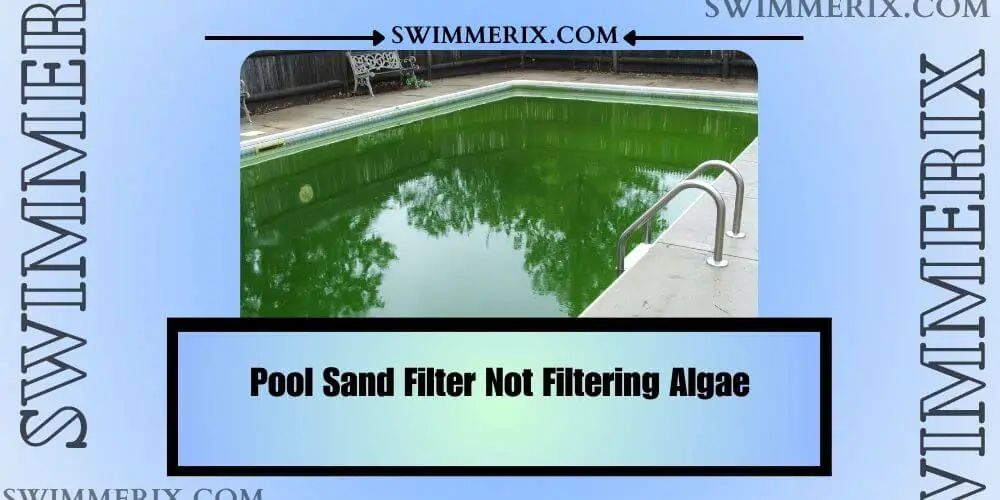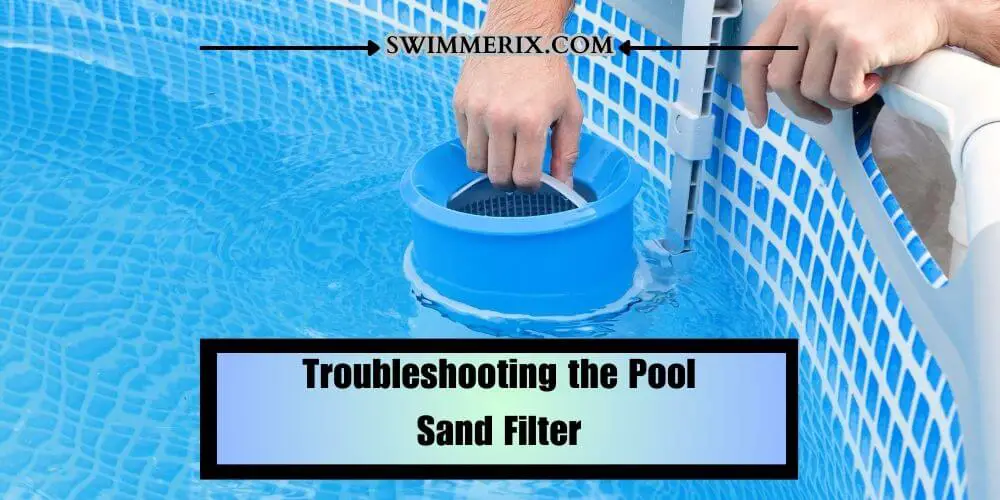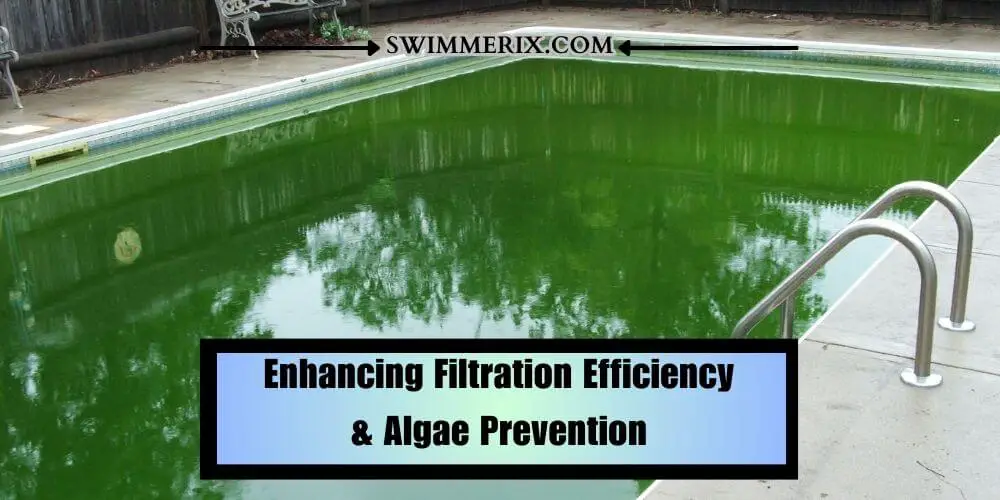
If you want to maintain a clean & inviting swimming pool, you must install an effective filtration system. However, many pool owners face the frustrating issue of their ‘pool sand filter not filtering algae.’ If you also want to know ‘why is my pool sand filter not filtering algae, ‘ this article is for you. In this article, I will help you learn the causes of ineffective filtration and tips on troubleshooting the problem.
Here, we will also explore the preventive measures to help you keep your pool algae-free. No doubt that algae growth can quickly turn any pristine pool into a murky green mess which is not only unsightly uninviting but also quite frustrating.
Before I tell you the troubleshooting methods, it is important to know why algae thrive in pools and the causes of ineffective filtration for algae. Therefore let’s understand ‘why is my pool filter not filtering algae.’
Pool Sand Filter Not Filtering Algae: 5 Common Causes
Your pool filter may not be filtering algae due to defective filter media in the filter tank or clogging in the filter media. Sometimes improper filter maintenance & lack of backwashing contributes to ineffective filtration. To prevent this issue, you need to troubleshoot your filter & clean it thoroughly. If you notice signs of damage, replace it.
Algae growth is usually influenced by factors like sunlight, warm water temperature, sanitizer level & filtration system. Hence, if there is sunlight and warm water, it will provide an ideal environment for algae to flourish.
In addition, if sanitizer levels are insufficient, the algae will start to multiply rapidly, especially in warm water. However, even with proper sanitization, inadequate filter filtration can also contribute to algae growth & infective filtration. Now that you know why your ‘pool sand filter is not filtering algae,’ let’s discuss these causes more in-depth to understand what you can do about it.
Insufficient Filter Media (Sand) in the Filter Tank
You must pay attention to the quantity of filter media in the filter tank. The quantity of filter media, usually sand, is crucial for effective filtration. Therefore, if there are insufficient sand levels, it will further compromise the filter’s ability to trap algae & other particles.
Therefore, please ensure your filter tank has the recommended amount of sand per the user manual. Below, I also mentioned a table outlining the recommended sand level for different filter tank sizes. But, if you want to learn Cost to Replace Sand in Pool Filter, check this post.
| Filter Tank Size | Recommended Sand Level |
| 16 inches | 100 pounds |
| 19 inches | 150 pounds |
| 22 inches | 200 pounds |
However, if your filter tank size needs to be covered here, never mind; consult a professional pool service provider who can help you assess the situation & give appropriate solutions tailored to your specific needs & your filter types & size.
Filter Media Clogging
Another major contributor to filter sand filters not filtering algae could be clogging. Over time, filter media can become clogged, impeding the filtration process. You should know that clogging may occur due to many factors, like the accumulation of debris or oil.
Sometimes organic matters also block the filter media impeding the filtration process. The clogged filter will reduce water flow and hamper its ability to filter out algae effectively.
Therefore, you must pay attention to regular maintenance & cleanliness to prevent media clogging. Since it can be tough for the first-time pool owner to clean the filter media as it requires some skills, never mind contacting a professional to do it for you.
Improper Filter Maintenance
Improper filter maintenance also contributes to the improper performance of filtering algae. Thus, you must pay tension to maintain your sand filter for optimal performance. If you have paid attention to the regular pool maintenance task, it will further lead to effective filtration. Below I am mentioning some important maintenance tips that you should always follow & adhere to as long as you have a pool in your backyard or on your property.
What To Do?
Regular Backwashing & Rinsing
You must pay attention to the backwashing process, where you reverse the water flow to flush out any trapped debris from the filter media. I usually like to do it once a week at least. However, Eco Outdoor recommended to backwash the filter every 1-2 weeks or when your filter’s pressure gauge reads 8-10 PSI (pounds per square inch). However, if you find Sand in Pool After Backwash, there can be multiple culprit.
Ensure you’re following the proper backwashing process & remember to rinse the filter that, can remove any remaining debris as well. Sometimes, you also have to take the help of a brush to clean out any stuck debris.
Sand Replacement
With continuous usage over time, sand particles can become worn out & lose their effectiveness. Experts recommend replacing the filter sand every 3 to 5 years. However, it may also vary depending on your pool usage and the manufacturer’s guidelines. Therefore, never hesitate to contact your manufacturer to determine the ideal time to replace the filter sand, depending on the usage & the filter type.
Cleaning & Maintenance Tips
It’s also important that you regularly inspect your filter system for any signs of damage or leaks. Yes, damaged or leaf filter systems will be ineffective in filtering algae and dust particles.
You must clean the skimmer and the pump basket to ensure proper water circulation. Inadequate water circulation can lead to algae growth and cloudy water. Therefore, I recommend using a filter cleaner to remove any oil or other contaminants hindering the filtration process. Other than this, you can also use a degreaser to remove oil or other debris.
Troubleshooting the Pool Sand Filter

After understanding the major culprit of why it is not filtering algae, there are several troubleshooting steps you can take to identify & preserve the issue effectively.
Since it can be tough for a newbie to detect the actual culprits, these troubleshooting steps will help you guide with the appropriate course of action to take.
Or, you can also hire a professional who can assess the situation & the filter for you while determining the best course of action, specially tailored to your specific need.
Identifying Signs of Ineffective Filtration
If you spot cloudy water or continuous algae growth despite regular filtration & maintenance, it is a clear indication that something is amiss. This is also the first step to recognize the signs of infective filtration. Therefore, if you notice these signs, it’s time to dig deeper into the problem & assess the situation to solve it.
Testing & Adjusting Water Chemistry
Apart from paying attention to the filtration only, you should also test & determine the water chemistry. Proper water chemistry is very important for effective filtration & algae prevention. Therefore, always consider testing your pool water regularly & adjusting the pH & sanitizer levels as required.
You should purchase a reliable water testing kit that can measure the chemical balance of your pool water, including chlorine and pH levels. If you need to know the best chemical parameters, below, you’ll find a list of the optimal range for balanced pool water parameters. If you maintain these levels, you can create an environment that discourages algae growth and support an efficient filtration system.
- pH: 7.2-7.6
- Free Chlorine: 2-4 ppm
- Total Alkalinity: 80-120 ppm
Here, you can learn “How to Raise pH Without Raising Alkalinity“.
Inspecting & Cleaning the Filter System
The last thing you need to troubleshoot is to check the filtration system on the regular inspection & cleaning of the system for optimal filtration & circulation of water. You first need to start by turning off the pump & closing the valves. After that, make sure to follow the steps mentioned below
- Inspect The Filter Media: To inspect the filter media, you first need to remove the filter tank’s lid & visually inspect them. If you notice any signs of deterioration or clogging in a tank, ensure to clean it. In case of deterioration, you will have to replace the media, which will strain your wallet againet.
- Cleaning Techniques: A filter cleaner or degreaser is a very effective method to clean the filter media. However, ensure you are using this product according to the instructions for the correct application. Another option to clean out the filter media is by soaking it in a solution of water & muriatic acid. After shocking the media for about half an hour, you must rinse it thoroughly before returning it to the filter tank.
- Inspect Other Components: Since you have the filter open, you should also pay attention to inspecting the pump & impeller for any debris or damage that might be culprits for ineffective filtration of algae growth. If required, clean out the pump basket & check for water circulation. If you notice any abnormality or issues affecting the filtration process, address it promptly.
Potential Issues Beyond the Filter
If you have followed all the troubleshooting steps mentioned above & your filter still fails to filter out, there can be other underlying issues affecting the filtration system. Therefore, make sure your considering both the possibilities mentioned below.
Circulation Problems
There may be a problem with the circulation of water. No doubt that inadequate water circulation also hinders filtration & contributes to algae growth. Therefore, I recommend you ensure all pool jets & returns are properly positioned to optimize water movement effectively. Also, check for any obstructions or blockages that might impede water flow.
Pump Functionality
Your pump has gone faulty, which could be impacting the filtration system. The malfunctioning pump cannot only significantly impact filtration but also water clarity. Therefore, if there is an issue with the pump, I suggest you contact a professional who can assess the situation, inspect the pump, & repair it for you. If preparing is impossible, you must replace the whole pump, hindering your budget.
Enhancing Filtration Efficiency & Algae Prevention

Our information has helped you troubleshoot the problem. In addition to troubleshooting the filter, there are several steps & make sure you can take to enhance its efficiency & prevent Brown Algae in Pool too. If you follow all the steps below, you can effectively prevent algae growth & sports.
Upgrading the Filter System
First of all, if your current filter face provides inadequate filtration, consider upgrading. Many high-quality sand filters in the market come with advanced features known to improve filter efficiency & reducing the likelihood of algae growth.
However, when selecting a new filter, you must consider a few factors, like the filter size, flow rate, and filtration media options. Using diatomaceous earth filters for the last three years & offers superior filtration, so consider it a worthy alternative.
Implementing Preventive Measures
I don’t need to tell you that prevention is key regarding algae control in any pool. Therefore, you must be there to implement preventive measures that can significantly reduce the chances of algae growth in your pool. Below, I mention some preventive strategies that I find very effective in keeping the algae out of the pool.
Algaecides & Clarifiers
As a preventive measure, I will advise you to use inappropriate types of algaecides, depending on the type of algae you are dealing with. There are many types of algaecides available & suitable for specific algae problems. Remember that Too Much Algaecide in Pool can be detrimental for water & swimmers. On the other hand, you can also take the help of clarifiers which help maintain clear crystal water by grouping small particles & facilitating easier filtration.
Regular Brushing & Vacuuming
You should also pay attention to brushing the pool surface and vacuuming the pool regularly, which can help you remove algae pores. It will also prevent them from settling & multiplying. Also, you should pay extra attention to areas more prone to algae growth, like walls, corners, and steps. Also, people use bleach for mild algae problems. But the question is “Will Bleach Kill Algae in a Pool“. The answer is “Yes” to some extent.
Optimising Water Circulation
Lastly, you must ensure that all the pool jets & returns are properly adjusted to optimize effective water circulation. This will help distribute chemicals evenly and ensure thorough filtration of dust particles along with algae. In addition, consider running the pool pump for an adequate duration every day to promote better water circulation & filtration.
Conclusion
I hope you know ‘why is my pool filter not filtering algae’ & what you can do about it. Since a pool filter plays a vital role in maintaining a clean & algae-free swimming pool, ensure it functions properly.
I have given my best to give you & an in-depth understanding of the causes of ineffective filtration, troubleshooting the issue and implementing preventive measures to keep your pool crystal clear and inviting.
Also, if you want to maintain optimal filtration, pay attention to regular maintenance, proper water chemistry & thorough cleaning of the filtration system. Also, it is best to consider the professional when needed & stay proactive in preventing algae growth to keep your pool crystal clear & inviting. If you’ve any other concern regarding “pool sand filter is not filtering algae”, nevermind dropping a comment below
If you follow all the approaches & steps mentioned in this guide, you can enjoy a sparkling pool that provides hours of enjoyment for you, your family, & your friends. If you find this article where I have shared causes of pool filters not filtering algae’ consider sharing it.
Your share is not only going to hell for people to learn why their ‘pool filter is not filtering algae’ but also what they can do about it & prevent this situation from recurring. Check my other helpful guide on pool care & maintenance, along with algae control. See you in the next post, till then, take care & goodbye.

